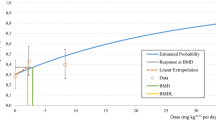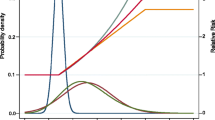Abstract
The term “excess lifetime cancer risk” connotes the risk of death of cancer in excess of the “natural” background risk, resulting from a lifetime exposure to carcinogens. In practice, exposure is not for a lifetime, competing causes are prominent, the exposure usually comprises more than one carcinogen, and the risk of cancer death may be substantially reduced by therapy. Therefore, the following points and questions and questions may be considered. (1) The estimated excess unconditional risk based on animal bioassays overestimates the risk for humans. A conditional risk, however, would require life-table techniques, for which age-specific mortality rates are essential but difficult to obtain. (2) For a shorter-than-lifetime exposure, the Weibull time model appears to be inadequate because it does not accommodate for the probable significant reduction of additionally accrued incremental risk after cessation of exposure. (3) Should the level of risk used for initiating public health activities be the same as that for initiating remedial actions? (4) When populations are exposed to multiple chemicals, should decisions concerning public health be based on the sum of the risk estimates for all of the chemicals or on the highest risk estimate for one chemical? (5) When small populations are exposed, should the predicted actual excess number of cancer deaths rather than a predicted risk level be the sole basis for decisions on public health and remedial action?
Access this chapter
Tax calculation will be finalised at checkout
Purchases are for personal use only
Preview
Unable to display preview. Download preview PDF.
Similar content being viewed by others
References
Littlefield, N.A., Greenman, D.L., Farmer, J.H., and Sheldon, W.G. “Effects of Continuous and Discontinued Exposure to 2-AAF on Urinary Bladder Hyperplasia and Neoplasia. J. Environ. Pathol. Toxiocl. 3: 17–34, 1979.
Day, N.E., and Brown, C.C., Multistage Models and Primary Prevention of Cancer. J. Natl. Cancer Inst. 64: 977–989, 1980.
Tomatis, L., Tutosov, F., Charles, R.T., Boiocchi, M., and Gatt, E. “Liver Tumors in CF-1 Mice Exposed for Limited Periods to Technical DDT.” Z. Krebsforsch 82:-25–35, 1974.
Environmental Protection Agency. “National Primary Drinking Water Regulations; Volatile Synthetic Organic Chemicals; Proposed Rule Making.” Federal Register, June 12, 1984, pp. 24330–24355.
National Academy of Sciences. “Drinking Water and Health.” National Academy Press, Vol. III, 25–61, 1980.
National Cancer Institute, “Bioassay of 1,4-dioxane for Possible Carcinogenicity.” NCI Technical Report Series 80–1978, DHEW (NIH) 78–1330.
Environmental Protection Agency. “Water Quality Criteria Documents; Availability.” Federal Register, November 28, 1980, pp. 79318–79379.
Executive Office of the President, Office of Science and Technology Policy. “Chemical Carcinogens; Review of the Science and its Associated Principles.” Federal Register, May 22. 1984, pp. 21594–21661.
Author information
Authors and Affiliations
Editor information
Editors and Affiliations
Rights and permissions
Copyright information
© 1987 Plenum Press, New York
About this chapter
Cite this chapter
Freni, S.C. (1987). Application of Estimated Excess Lifetime Cancer Risk in Field Situations. In: Covello, V.T., Lave, L.B., Moghissi, A., Uppuluri, V.R.R. (eds) Uncertainty in Risk Assessment, Risk Management, and Decision Making. Advances in Risk Analysis, vol 4. Springer, Boston, MA. https://doi.org/10.1007/978-1-4684-5317-1_27
Download citation
DOI: https://doi.org/10.1007/978-1-4684-5317-1_27
Publisher Name: Springer, Boston, MA
Print ISBN: 978-1-4684-5319-5
Online ISBN: 978-1-4684-5317-1
eBook Packages: Springer Book Archive




